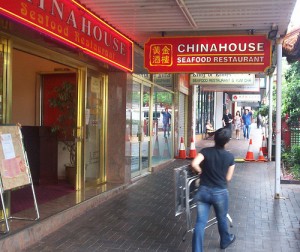Brisbane aspires to be a world-class city but still suffers from its redneck past.
Sydney figured out some of the aspects of restaurant inspection disclosure, or grades, five years ago, five years after Toronto did, a decade after Los Angeles, decades after San Diego, and four years before New York City. Melbourne is still asleep. Brisbane, with a new state government, is at least showing signs of waking up.
As reported by The Sunday Mail this morning, vermin, hundreds of cockroaches, and rat poison on a kitchen _story(1).jpg) bench – these are some of the restaurant nightmares being kept from the (Queensland) public.
bench – these are some of the restaurant nightmares being kept from the (Queensland) public.
Diners are being left in the dark about filthy rat and cockroach-infested restaurants thanks to the state’s broken "name and shame" regime.
A so-called restaurant "black list" was introduced by the Labor government in 2006 to expose kitchen cowboys caught breaking food-safety laws.
But a Sunday Mail investigation can reveal some of the most serious breaches risking diners’ health have never been listed, even after conviction.
An analysis of council reports obtained under Right to Information laws show eateries prosecuted and fined $40,000 or more over breaches last year were among those not mentioned on the Queensland Health public register, while others fined as little as $2000 over lesser offences are included.
Those to escape the public register include a sushi restaurant fined $45,000 after inspectors found a "serious risk to public health".
A cafe hit with court fines after hundreds of cockroaches were found on site by inspectors is another to escape naming and shaming.
The business owners all got away without having convictions recorded, meaning Queensland Health will not list their names on the register.
Meanwhile, a Red Rooster restaurant fined $50,000 for breaches last year did have a conviction recorded but still escaped the list.
Another 200 food businesses fined over food safety breaches by Queensland councils last year will also not have their names released.
Just seven food businesses have been named on the list despite 14 successful prosecutions by councils on the Gold Coast and in Brisbane last year.
That compares to the 43 businesses named and shamed after prosecutions and 1200 businesses named after being fined in NSW (that’s the state where Sydney is found).
The LNP Government will now shut down the register and consider the introduction of a mandatory "scores on doors" restaurant rating scheme.
A spokesman for Health Minister Lawrence Springborg said the register was painting a "misleading" picture of the true extent of food breaches.
"What is the point of a website that really catches a very small percentage of breaches and creates a false impression in peoples’ minds," he said. "We aren’t that far away from the possibility of a scores on doors scheme, but it is going to be up to councils and the consultation process."
If you need some help with that, we have some experience.
Restaurants and food service establishments are a significant source of the foodborne illness that strikes millions of diners in so-called developed countries each year.
.jpg) After watching the mish-mash of federal, state and local approaches to restaurant inspection in a number of western countries for the past 20years, I can draw two broad conclusions:
After watching the mish-mash of federal, state and local approaches to restaurant inspection in a number of western countries for the past 20years, I can draw two broad conclusions:
• Anyone who serves, prepares or handles food, in a restaurant, nursing home, day care center, supermarket or local market needs some basic food safety training; and,
• the results of restaurant and other food service inspections must be made public.
Here’s why.
Parenting and preparing food are about the only two activities that no longer require some kind of certification in Western countries. For example, to coach little girls playing ice hockey in Canada requires 16 hours of training. To coach kids on a travel team requires an additional 24 hours of training.
It’s unclear how many illnesses can be traced to restaurants, but every week there is at least one restaurant-related outbreak reported in the news media somewhere. Cross-contamination, lack of handwashing and improper cooking or holding temperatures are all common themes in these outbreaks — the very same infractions that restaurant operators and employees should be reminded of during training sessions, and are judged on during inspections.
There should be mandatory food handler training, for say, three hours, that could happen in school, on the job, whatever. But training is only a beginning. Just because you tell someone to wash the poop off their hands before they prepare salad for 100 people doesn’t mean it is going to happen; weekly outbreaks of hepatitis A confirm this. There are a number of additional carrots and sticks that can be used to create .jpg) a culture that values microbiologically safe food and a work environment that rewards hygienic behavior. But mandating basic training is a start.
a culture that values microbiologically safe food and a work environment that rewards hygienic behavior. But mandating basic training is a start.
Next is to verify that training is being translated into safe food handling practices through inspection. And those inspection results should be publicly available.
A philosophy of transparency and openness underlies the efforts of many local health units across North America in seeking to make available the results of restaurant inspections. In the absence of regular media exposes, or a reality TV show where camera crews follow an inspector into a restaurant unannounced, how do consumers — diners — know which of their favorite restaurants are safe?
Cities, counties and states are using a blend of web sites, letter or numerical grades on doors, and providing disclosure upon request. In Denmark, smiley or sad faces are affixed to restaurant windows.
Publicly available grading systems rapidly communicate to diners the potential risk in dining at a particular establishment and restaurants given a lower grade may be more likely to comply with health regulations in the future to prevent lost business.
More importantly, such public displays of information help bolster overall awareness of food safety amongst staff and the public — people routinely talk about this stuff. The interested public can handle more, not less, information about food safety.
Lots of cities still do not disclose restaurant inspection results, worried about the effect on business, but they aren’t great cities.
Brisbane wants to be great.
And instead of waiting for politicians to take the lead, the best restaurants, those with nothing to hide and everything to be proud of, will go ahead and make their inspection scores available and actively promote their food safety efforts — today.
We really do have experience with this.
Filion, K. and Powell, D.A. 2009. The use of restaurant inspection disclosure systems as a means of communicating food safety information. Journal of Foodservice 20: 287-297.
Abstract
??The World Health Organization estimates that up to 30% of individuals in developed countries become ill from food or water each year. Up to 70% of these illnesses are estimated to be linked to food prepared at foodservice establishments. Consumer confidence in the safety of food prepared in restaurants isfragile, varying significantly from year to year, with many consumers attributing foodborne illness to foodservice. One of the key drivers of restaurant choice is consumer perception of the hygiene of a restaurant. Restaurant hygiene information is something consumers desire, and when available, may use to make dining decisions.
Designing a national restaurant inspection disclosure system for New Zealand?
01.nov.11
Journal of Food Protection 74(11): 1869-1874
Katie Filion and Douglas Powell?
Department of Diagnostic Medicine/Pathobiology, Kansas State University, Manhattan, Kansas 66506, USA
?http://www.ingentaconnect.com/content/iafp/jfp/2011/00000074/00000011/art00010
?The World Health Organization estimates that up to 30% of individuals in developed countries become ill from contaminated food or water each year, and up to 70% of these illnesses are estimated to be linked to food service facilities. The aim of restaurant inspections is to reduce foodborne outbreaks and enhance consumer confidence in food service. Inspection disclosure systems have been developed as tools for consumers and incentives for food service operators. Disclosure systems are common in developed countries but are inconsistently used, possibly because previous research has not determined the best format for disclosing inspection results. This study was conducted to develop a consistent, compelling, and trusted inspection disclosure system for New Zealand. Existing international and national disclosure systems were evaluated. Two cards, a letter grade (A, B, C, or F) and a gauge (speedometer style), were designed to represent a restaurant’s inspection result and were provided to 371 premises in six districts for 3 months. Operators (n = 269) and consumers (n = 991) were interviewed to determine which card design best communicated inspection results. Less than half of the consumers noticed cards before entering the premises; these data indicated that the letter attracted more initial attention (78%) than the gauge (45%). Fifty-eight percent (38) of the operators with the gauge preferred the letter; and 79% (47) of the operators with letter preferred the letter. Eighty-eight percent (133) of the consumers in gauge districts preferred the letter, and 72% (161) of those in letter districts preferring the letter. Based on these data, the letter method was recommended for a national disclosure system for New Zealand.
 cancellation and has just published reasons for that decision.
cancellation and has just published reasons for that decision.




 collective alertness of a bag of hammers.
collective alertness of a bag of hammers. accessories.
accessories._story(1).jpg) bench – these are some of the restaurant nightmares being kept from the (Queensland) public.
bench – these are some of the restaurant nightmares being kept from the (Queensland) public..jpg) After watching the mish-mash of federal, state and local approaches to restaurant inspection in a number of western countries for the past 20years, I can draw two broad conclusions:
After watching the mish-mash of federal, state and local approaches to restaurant inspection in a number of western countries for the past 20years, I can draw two broad conclusions:.jpg) a culture that values microbiologically safe food and a work environment that rewards hygienic behavior. But mandating basic training is a start.
a culture that values microbiologically safe food and a work environment that rewards hygienic behavior. But mandating basic training is a start. Restaurant inspection disclosure in Brisbane (that’s in Australia) sucks because it’s voluntary: only two stars out of five? No need to post.
Restaurant inspection disclosure in Brisbane (that’s in Australia) sucks because it’s voluntary: only two stars out of five? No need to post..jpg)

.jpg) But they’re so cute.
But they’re so cute.